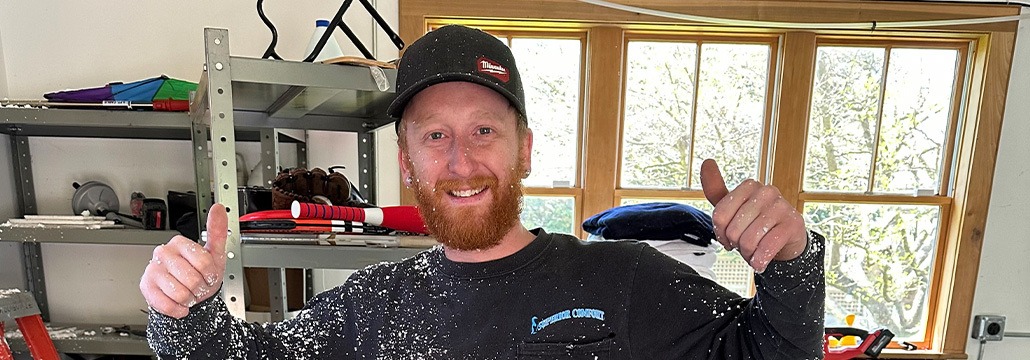Since heating and cooling your home accounts for more than half of your energy use, it’s only smart to reduce waste. No matter what type of heating and cooling system you have in your home, some simple steps will increase efficiency and reduce environmental emissions from 20 to 50 percent. You can start by combining upgrades and professional equipment maintenance with recommended insulation and thermostat settings.
Install a programmable thermostat to easily raise and lower settings depending on your needs. In the cold season, set your thermostat to the lowest possible setting while still maintaining comfort, and vice versa in the warm season. Raise or lower the setpoint, depending on the season, when you are sleeping or away from home.
Perform some heating and cooling house cleaning. Clean air filters on air conditioners and furnaces once a month and replace them as needed. Whenever necessary, clean radiators, baseboard heaters, and warm-air registers. Avoid blocking equipment with drapes, furniture, or carpeting.
Once or twice a season, eliminate trapped air from hot-water radiators. Keep in mind it’s often better to let the professionals handle this task.
Make sure to turn off exhaust fans in the kitchen and bath within twenty minutes after you are finished cooking or bathing. When replacing exhaust fans, look for high-efficiency, low-noise models.
In summer, lower the air conditioner’s fan settings in order to remove more humidity and boost comfort while saving energy.
Insulating ducts that move air to-and-from a forced air furnace, central air conditioner, or heat pump can improve the efficiency of your HVAC system by as much as 20 percent. Concentrate on insulating ducts that run through the attic, unheated basement, or garage. Seal the seams and connections with duct sealant (mastic) or metal-backed (foil) tape, then wrap them in insulation to keep them from getting hot in the summer or cold in the winter.
You can also lessen the workload of your heating system by keeping curtains and shades on south-facing windows open during the day to let sunlight in and closed at night to keep the cool chill out. During summer, help out your air conditioning by closing window coverings during the day to block the sun’s heat.
Superior Comfort Specials
Buy 2 Get 1 Free
Smart Outlets
Schedule ServiceTax is not included Cannot be combined with any other offers or memberships. Cannot be used on past work. Must be presented at time of proposal. Some exclusions may apply. See website for licensure. Offers Expire: 02/01/2026
$49
Electrical Safety Check
Schedule ServiceTax is not included Cannot be combined with any other offers or memberships. Cannot be used on past work. Must be presented at time of proposal. Some exclusions may apply. See website for licensure. Offers Expire: 02/01/2026
$99
Drain Clearing w/ free camera inspection
(Tax Not Included)
Schedule ServiceTax is not included Cannot be combined with any other offers or memberships. Cannot be used on past work. Must be presented at time of proposal. Some exclusions may apply. See website for licensure. Offers Expire: 02/01/2026
Up to $1000
System Buy Back With purchase of a new system
Schedule ServiceTax is not included Cannot be combined with any other offers or memberships. Cannot be used on past work. Must be presented at time of proposal. Some exclusions may apply. See website for licensure. Offers Expire: 02/01/2026
$50 Off
Any Repair over $200
Schedule ServiceTax is not included Cannot be combined with any other offers or memberships. Cannot be used on past work. Must be presented at time of proposal. Some exclusions may apply. See website for licensure. Offers Expire: 02/01/2026
$99 Tune Up
(Excluding Oil Systems)
Schedule ServiceTax is not included Cannot be combined with any other offers or memberships. Cannot be used on past work. Must be presented at time of proposal. Some exclusions may apply. See website for licensure. Offers Expire: 02/01/2026
$79
Holiday Electrical Safety Check
Schedule ServiceTax is not included Cannot be combined with any other offers or memberships. Cannot be used on past work. Must be presented at time of proposal. Some exclusions may apply. See website for licensure. Offers Expire: 01/01/2026
Up to $500
Rebate on Water Heater Install
(Excluding Tankless)
Schedule ServiceTax is not included Cannot be combined with any other offers or memberships. Cannot be used on past work. Must be presented at time of proposal. Some exclusions may apply. See website for licensure. Offers Expire: 02/01/2026
Up To $150 Off
Drain Clearing with Free Camera Inspection
Schedule ServiceCannot be combined with any other offers or memberships. Cannot be used on past work. Must be presented at time of proposal. Some exclusions may apply. See website for licensure. Offers Expire: 01/01/2026
Up to $200 Off
Duct Cleaning
Schedule ServiceTax is not included. Cannot be combined with any other offers or memberships. Cannot be used on past work. Must be presented at time of proposal. Some exclusions may apply. See website for licensure. Offers Expire: 01/01/2026
Up to $500
Towards Stand by Generator Installation
Schedule ServiceCannot be combined with any other offers or memberships. Cannot be used on past work. Must be presented at time of proposal. Some exclusions may apply. See website for licensure. Offers Expire: 01/01/2026
Up To $1,000 Off
HVAC Replacement
Schedule ServiceCannot be combined with any other offers or memberships. Cannot be used on past work. Must be presented at time of proposal. Some exclusions may apply. See website for licensure. Offer Expire: 01/01/2026
What Our Customers Say About Us
The crew from Superior Comfort just left our home and in one day we got three heads and one condenser installed. The experience that started with Matt the sales rep and continued with Evan and then finished up with John, Derrick, Josh, Parker and the entire crew was fantastic! Communication between my wife, and I and the company was always kind and direct. We never felt like we couldn’t ask a question, we never felt rushed, and we always felt like we were in good hands. Each time a step in the process was scheduled, furious people from the company Showed up when they said they would and took us through the entire process seamlessly. The work that got done today was clean, aesthetically, pleasing, and the final tests of the system were all outstanding! We would absolutely work with this company again.
Show MoreRaymond Votolato
I’m very satisfied with the work Matt did in replacing my outside water faucet and replacing my basement pipe. Matt was very prompt and called me this morning to let me know he was on his way. He took the time to explain things to me and answered all of my questions. Thanks Matt!
Show Morebass2 see
Aaron was prompt, professional, and personable! Thank you for providing quality service!
Show MoreAdam Kropp
Bob was professional and showed me exactly what the plumbing issue was. He provided two options and quotes for the plumbing problem.
Show MorePatricia Perry
Quick fabulous service with a well educated professional. Would use them again without hesitation
Show MoreChristine Fox
Mark from superior comfort was a great representative. He explained the project in detail, and broke down the costs. I ultimately went with another contractor based on bottom line cost, but Mark’s professionalism’s was appreciated
Show MoreAnthony Perretta
Amazing service. They are respectful, kind and conscientious. I highly recommend them. The have the best pricing as well. I’m very happy with Superior Comfort!
Show MoreRenee Arnold
Alex is a friendly and knowledgeable technician and fixed everything quickly and reliably
Show MoreStephanie West
Aaron was very informative and knowledgeable of the products.
Show MoreManuel Bernardo
Very professional and experienced young man serviced my units and educated me on the process to replace my very old AC units.
Show MoreGregory Pearson
Robert was very professional and.helpful for us to understand our problem
Show MoreDonna Hagh
Mark is a professional at providing all the necessary information for my plumbing needs. He is an asset to Superior Comfort.
Show MoreSue
Jade was very efficient, pleasant and thoughtful. Top notch service.
Show MoreRobert Sorenson
Superior comfort provides superior service in their maintenance of our air conditioning and mini split systems. Their staff are extremely knowledgeable and professional and are a pleasure to have in your home. I highly recommend this company!
Show MoreScott Throwe
Aaron Parsons was extremely polite and efficient. Happy to recommend the service.
Show MoreChristie Smith

FLEXIBLE FINANCING OPTIONS
Get the comfort you need without the upfront cost. We offer easy and affordable payment plans to fit your budget.







